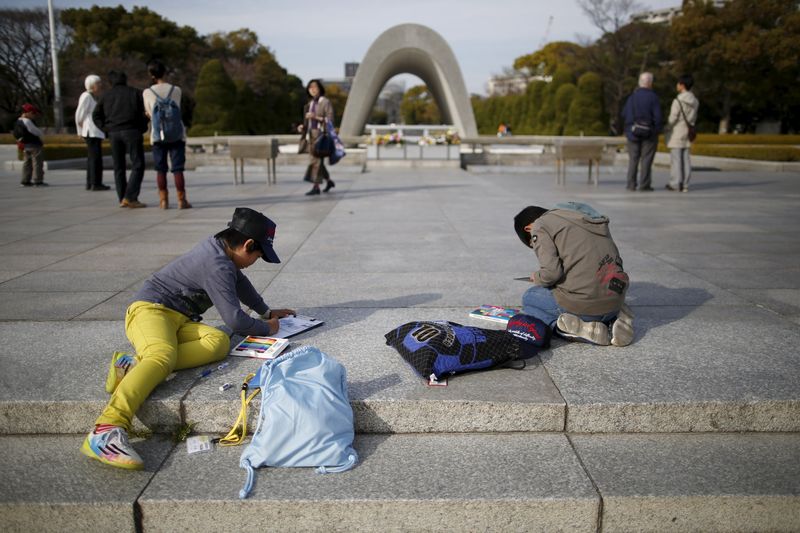By Kiyoshi Takenaka
HIROSHIMA, Japan (Reuters) - Hiroshi Harada remembers how his leg sank into one of the bodies blocking a narrow Hiroshima street 70 years ago, as he fled the spreading fire ignited by the atomic bomb.
"My leg slid deep into one of them. Then it was very hard to pull my leg out ... To escape, I had no choice," said Harada, the 75-year-old former head of an atomic bomb museum.
Later that day, a woman grabbed Harada, then just 6 years old, by the leg and asked for water. He stepped back in horror to find a chunk of flesh from her hand sticking to his leg.
As the 70th anniversary of the world's first nuclear attack approaches, many survivors still find it too painful to talk about. But with their ranks dwindling, others are determined to pass on their experiences to younger generations.
"The number of survivors will be shrinking and their voices getting smaller," Harada said. "But Hiroshima needs to keep on sending a message to the world that things like this should never happen again."
Hiroshima survivors often refrain from talking about their experiences even with their own children, some from a feeling that the past is too horrific and others from fear of discrimination against themselves and their offspring.
This year's anniversary comes as Prime Minister Shinzo Abe seeks to ease the constraints of Japan's postwar, pacifist constitution on the military.
Critics fear that could lead the nation again down a mistaken path to war, while proponents argue the change is needed to deter growing regional threats.
FEELING OF SHAME
A U.S. bomber dropped the atomic bomb on Hiroshima on Aug. 6, 1945, killing about 140,000 by the end of the year, out of the 350,000 who lived in the city. The city still has some 60,000 survivors but their average age is approaching 80.
The United States dropped a second atomic bomb on Nagasaki three days after Hiroshima. Japan surrendered on Aug. 15.
Shortly after the bombing, 15-year-old Shigeo Ito was hurrying home and was asked by a woman to help rescue a person trapped under a collapsed house. He ignored the plea since fire was approaching the bridge he needed to cross to get home.
"Even long after that, I could not help feeling ashamed of myself every time I saw that bridge," said the 84-year-old Ito, who now lectures to school children about his experience.
Shuntaro Hida, 98, was an army surgeon at the time of the bombing. When he first went out after the explosion, he saw a woman with what he thought were tattered clothes hanging from her torso. Then he realised he was seeing her sloughed-off skin.
For Hida, however, the real horror of the nuclear attack lay in its often invisible health effects. "The cruellest aspect of a nuclear attack is not the savage destruction of human bodies or visible burns, but its life-destroying after-effects," said Hida, who treated and advised some 10,000 atomic bomb survivors.
Hiroshima began to see an increased number of leukaemia patients five year after the bombing.
Fumiaki Kajiya, 76, lost his sister to the atomic bomb blast. Their parents had moved her to a rural area to keep her safe, but just before the bombing, they brought her back to the city, succumbing to her pleas to stay with the family.
Kajiya's mother would weep for hours on end in front of the Buddhist alter as Aug. 6 came around every year. Kajiya now performs "picture shows" for children with hand-drawn art to pass on the horror of the atomic bomb.
"If we forget Hiroshima, the world would be a dangerous place," Kajiya said.
